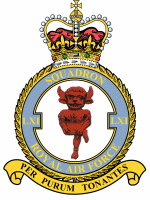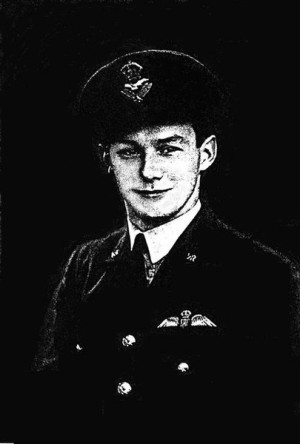Squadron Leader H.W.Horsley AFC
He was 2nd pilot in F/O Innis's crew for the night operation to STUTTGART 12/13 September 1944.
He took part in the operation to BOULOGNE 17 September 1944.
The crew being:
- S/L H W Horsley (Capt)
- P/O C A Cawthorne (F,Eng)
- F/O J C Webber (Nav)
- F/O J P Wheeler (A/B)
- F/S G Twyneham (WT/Air)
- Sgt H W Jennings (AG1)
- Sgt R T Hoskisson (AG2)
The target for their 5th operation was the DORTMUND/EMS CANAL at LADBERGEN, 15 MILES NORTH OF MUNSTER, 23/24 September 1944. Their aircraft QR-K.
Sgt Hoskisson records:
Shortly after crossing the Dutch coast we were attacked by a Bf 110, both gunners engaged and the enemy aircraft broke away. We were then concentrated on by flak batteries and suddenly found ourselves coned by searchlights. The Skipper dived the aircraft down from 20,000 feet, and by 10,000 feet we had lost the searchlights. However our real trouble now began. The aircraft was not responding to the controls. We continued to lose control and it was deemed prudent to jettison the bombs and return to base. However when the load went the aircraft became even more difficult to control and despite the combined efforts of the Skipper and the Flight Engineer, backwards pressure on the control column was having no effect and we continued down alarmingly. The order was given to abandon aircraft. From my position I swung the turret round, slid open the rear door, disconnected my oxygen tube and intercom and fell out backwards. The next thing I knew I was floating downwards, everything was quiet and peaceful, save for a faint hum of the wind in the shroud lines. Now a new noise kept repeating itself and I realised that the war was becoming somewhat personal...I was being fired at from the ground.
I continued to search the ground keenly. I could see trees and hedges clearly. I realised I was droppng straight down but carrying along above the ground at a very fast rate. It was then that I saw my first German soldiers, they were positioned some distance apart from one another. I was very close to the ground and heading straight for one chap. He was running towards me, having misjudged my speed of approach and caught him, full force, in the face with my boot as we collided. There was a sickening crack. I was on the ground now being bundled along by the force of the wind. Three times before I could release myself from the harness I was carried back up into the air. I was along way from the soldiers now. Finally I managed to collapse the canopy and quickly disposed of it into a ditch. I made off quickly as I could across fields and soon came to a rough track. I followed this and eventually came to a farmstead. The place seemed deserted. I approached with caution but a dog began to bark. Soon a faint chink of light appeared, a door opened and a man appeared. There was nothing for it now; I approached, we stared at each other. I spoke, "Dutch?" He drew himself up "Hollander ... Deutsch kaput" and spat on the ground. From this I knew I was safe. I said I was RAF and pointed to the sky, by my appearance, he must have been convinced and dragged me into his house. His wife and little girl appeared and the next few minutes were confusion................
It is known from a Dutch source that aircraft LM718. QR-K was damaged by flak and then finished off by a fighter attack, crashing near Deurne in Holland at 2230hrs.
- S/L Horsley - Escaped.
- P/O Cawthorpe - Escaped.
- F/O Webber - PoW.
- F/O Wheeler - PoW.
- F/S Twyneham - Killed.
- Sgt Jennings - Killed.
- Sgt Hoskisson - Escaped
Crash on take off.
S/L Horsley and Sgt Hoskisson both returned to 61 Sqn, and continued their service.
1st February 1945; 13th Operation; Target Seigen
Lancaster NF 912 Take Off 1542hrs Return ----------
Crew
- S/L H W Horsley (Capt)
- W/O H J PYKE (F/E)
- F/S S Fleet (Nav)
- F/S Merrow (A/B)
- F/S Chapman (WOP/AIR)
- Sgt A A Sherriff (AG1)
- Sgt R T Hoskisson (AG2)
Aircraft crashed soon after take off due to engine failure. All crew killed except rear gunner
Extract taken from our 'Newsletter' of a report by Frank Mouritz, an ex 61 Sgn pilot :
"Take off time came and we were taxiing along the the taxiway in fading daylight. Aircraft L was two or three planes ahead of us. He took off and had engine failure just as he got airborne. All further take offs were halted as he did a slow turn at a few hundred feet and lined up on the grass beside the runway, as his speed was too slow to lower his undercarriage. He landed on his belly, skidded about 200 yds and then hit a bitumen taxiway...... The bomb load of 4,000 lb Cookie and 12,000 of 4 lb incendiaries (?) .........instantly blew up. We were waiting on the other side of the aerodrome and felt heavy blast and 4 lb incendiaries landed all around us. Horsley and 5 of his crew were killed in the explosion and the rear gunner, although badly injured, survived."
Another eye witness account of this happening was given by Sgt Alan Macdonald, a rear gunner on 50 Sqn, he had boarded his aircraft to join the same operation. His aircraft was still at it's dispersal point, and he was in his rear turret, going through the pre-checks on his guns prior to take-off.
Sgt McDonald saw that the fated aircraft, NF 912 was in difficulties immediately after leaving the ground, and was vainly struggling to land back on the runway. Over the runway it plunged to the ground, to explode with great violence. The aircraft was completely destroyed, being blown to bits by it's own exploding bomb load.
Amazingly, the runway was not damaged, and, after a contingent of other ranks, equiped with sweeping brushes, had cleaned the bits from the site, then the operation proceeded.
All aircraft were given an inspection for blast damage, some having been holed by shrapnel, and then, after a delay of some forty minutes, the take-off continued.
Some hours after the explosion, an airman, cycling in the dark on the airfield, spotted something glinting in a hedge. It was the rear turret of the lost Lancaster, and, amazingly, inside was the blackened body of the still alive gunner. That man was Hoskisson.
Emlyn Williams, an ex 50 Sqn MUG, witnessed the incident from the ground and tried to assist in the recovery of the crew; sadly in vain. He added:
"Mrs Horsley was kind enough to write thanking those who did their untmost to help at the seen of the accident".
The incident was all the more poignant for Frank Mouritz and his crew as their aircraft, QR-M, was unserviceable so they were allocated QR-L for the Siegen raid. But the take-off time was delayed by 2 hours, by which time his own QR-M became serviceable so they were given back their own aircraft and Sqn Ldr Horsley took QR-L.




